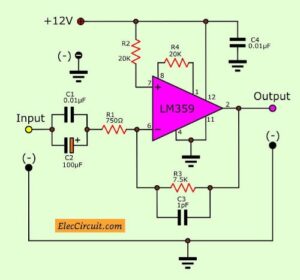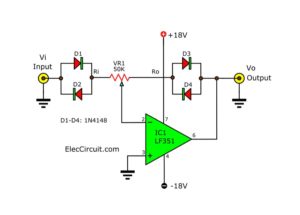This is a video amplifier splitter circuit or the video splitter circuit. It is designed to take video signals stronger and compensate for the loss of signal. Also, it is a video splitter with up to three outputs.

Therefore, it is suitable for display on several television screens, or videotape recording at the same time, too. (Now, may no a videotape.)
The advantage of this circuit is inexpensive, and easy, and a more detailed circuit is below.
Technical specifications
- Usually, the video amplifier circuit always has rate is a low amplifier. This circuit has the maximum gain ratio is only 4 times. Which it is different from the common pre-amplifier circuit, high gain.
- Impedance is 75 ohms on both the input and output.
- The bandwidth of this circuit is wide of 5 MHz.
How Video amplifier works
The circuit contains only three transistors.
- Q1 (BC547) and Q2 (BC557) act as a signal amplifier.
- Q3 (BD139 or BD137) serves as the output circuit of the common emitter follower.
The input impedance of the circuit is determined by the value of R1. The input signal enters through C2 to the base of Q1. And, the VR1 adjusts the level of the signal swing.
The output of Q1 is connected directly to the base of Q2. The amplified gain of the circuit is determined by adjusting VR2. Which is in the feedback circuit, between the collector pin of Q2 and the emitter pin of Q1.
However, the rate of gain depends on the ratio between the resistance of R5 and R6, R8, VR2, C3. The based on the used components in the circuit. We can get a gain of 1.95 to 8.7 times.
Thus, if the load is 75 ohms. The load will reduce the gain of the final amplifier section is half. The output signal is only 1-4 times.
You can change the resistance of R9 to suit the application. For example, if only single-channel networks. You use R9 is 150 ohms. But if the second channel is used for the network. The resistor R9 should be 82 ohms, and the current in the circuit will decrease.
The LM7812 is the main of the Dc voltage Regulator circuit in this project. I think you still know it very well, popular IC.
Read also
- How to install CCD camera sensor with VHF sender
- 3D stereo sound circuit & Split stereo signal & Balance Indicator
The building
You can assemble all components on a perforated board. You should put carefully the device in the circuit. Points of caution are capacitors, diodes, and transistors. You put always it the correct way.
Otherwise, the circuit does not work, and damaged.
If you want the PCB layout image of this project.
Look at below:

The copper PCB layout

The component PCB layout
The detail parts
0.25W Resistors
R1, R10, R11, R12: 75 ohms
R2: 10K
R3: 8.2K
R4: 1K
R5, R8: 180 ohms
R6: 3.3K
R7: 470 ohms
R9: 56 ohms
VR1, VR2: 2.2K, Potentiometer
C2, C8, C9: 0.1uF 50V_Polyester Capacitor
Electrolytic Capacitors
C1, C3: 10uF 16V,
C4, C5, C6: 100uF
C7: 470uF 25V
D1: 1N4148: 75V 150mA Diodes
D2, D3, D4, D5: 1N4001, 100V 1A Diodes
Q1: BC547b, BC546, 45V 100mA NPN Transistor
Q2: BC557B, BC556, 45V 100mA PNP Transistor
Q3: BD137, BD139 NPN transistor
IC1: LM7812, 12VDC voltage regulator IC
The setting of video amplifier circuit
When you are sure that the circuit is complete. Then, enter the power to the circuit to test by the following method. You can adjust VR1 in two ways.
First, adjust VR1 until the voltage at the base of Q1 is equal to 1V. And, there is a voltage drop across R7. (while no input signal.) approximately 0.75V.
Second, adjust VR1 in the middle, enter the input signal is 1Vp-p.
Then, adjust VR2 to the lowest rate of gain.
Next, connect the TV or monitor to output.
And, adjust VR1 until the test signal without distortion.
This circuit requires enough power supply. Do you have this one? If you do not have it. Look:A lot of Power supply circuit
Download This Post as a PDF and all PCB layouts

Keep reading:
The simple video amplifier circuit

I love electronics. I have been learning about them through creating simple electronic circuits or small projects. And now I am also having my children do the same. Nevertheless, I hope you found the experiences we shared on this site useful and fulfilling.





Perfect! i start to build it. And i need to distribute LEFT and RIGHT audio channels too.
nice url
Can this one also be use in audio?
I’m a noob, I don’t understand the connection of VR2… it has 3 legs, one goes to C10 and one to R8, the third one goes to ground or is just hanging there? Thanks
Hello! Í would like the PCB for this circuit please!
Hi Dante Klomp,
I will send you a PCB layout via email.
“Video amplifier splitter using transistor” schematic. Q2 is upside down. Feedback should come from the output emitter follower to reduce the output impedance and eliminate the interaction of the terminations. In fact, the output emitter follower should really be a totem-pole type circuit. Lastly, the 100uF output caps are too small a value – there will be vertical-tilt in the output video at high APL.
Q2 (BC 557)Emitter and collector reverse connection No such connection…
Hi Friend,
Thanks a lot. You are a great person. I have updated it. It is done.
Hi. Nice circuit. Can you send PCB for this circuit to my email. Please.
Hello Paul,
I am happy that you are interested this circuit.
Thanks